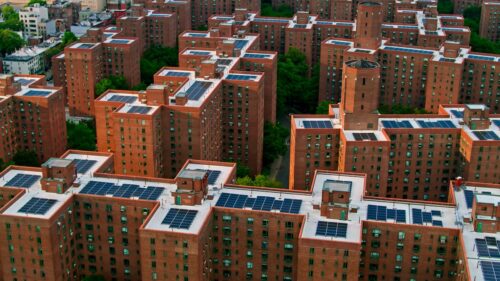Aerial establishing shot of Stuyvesant Town-Peter Cooper Village on the east side of Manhattan on a sunny evening in summer.

For Low-Income Communities, America’s Largest-Ever Clean Energy Investment Takes Shape
The EPA has announced $20 billion of Greenhouse Gas Reduction Fund awards. Here’s what you need to know about the program — and what comes next.
America’s largest-ever clean energy investment in low-income and disadvantaged communities will soon be deployed. Leveraged effectively, this investment — $20 billion from the EPA-administered Greenhouse Gas Reduction Fund (GGRF) — will deliver not just clean energy, but a transformation of financial markets.
On April 4, 2024, the Environmental Protection Agency (EPA) announced awardees in the two main GGRF programs: the $14-billion National Clean Investment Fund and the $6 billion Clean Communities Investment Accelerator. (Awardees in the third GGRF program, Solar For All, will be revealed later.) Here’s what you need to know about these awards — and what comes next:
National Clean Investment Fund (NCIF). NCIF awardees will focus on mobilizing private dollars and increasing the size and reach of investments, building a bridge from community financing to capital markets. These entities make direct investments, providing financing that complements and ushers in private dollars to deals that otherwise would not pencil out. NCIF strategies will include standardized and bespoke financing that can be deployed on a nation-wide basis to overcome shared and unique financing barriers across markets, regions, and clean technologies.
Awardees: Climate United, Coalition for Green Capital, Power Forward Communities
Clean Communities Investment Accelerator (CCIA). CCIA awardees will foster a national network of green financing entities. Awardees will make sub-grants, with funds earmarked for green projects, to capitalize community lenders and build capacity in climate finance. These entities will build on the local expertise and experience of the green bank and community lending markets. CCIA strategies will include developing climate know-how at existing institutions and capitalizing new entities to deliver the energy transition in ways that work for marginalized communities.
Awardees: Opportunity Finance Network, Inclusiv, Justice Climate Fund, Native CDFI Network, Appalachian Community Capital
With planned interventions to assist with the market-building efforts for GGRF deployment, [RMI is] leveraging the best of our teams for private market collaboration, policy analysis, financial innovation, and priority technology education.
$20 billion in the pipeline — now what?
EPA’s award announcements put wheels in motion — but the road to success is not yet fully paved. Until fund disbursal this summer, awardees will be negotiating final contract and program terms with the EPA. Meanwhile, a vast ecosystem of actors will need to mobilize in concert to build the skills, capacity, project pipeline, and coordination mechanisms for GGRF dollars to not only be quickly deployed, but to also ensure the program can deliver long-term, transformational benefits.
Aligning. In coming months, the awardees must coordinate with market players to align on the thresholds for key project goals of reducing carbon emissions, mobilizing investment in low- income and under-served communities, and leveraging private capital. Tools and methodologies need to be put in place in preparation for reporting — and up-front alignment is important so projects can start collecting the right data, right away. This coordination will ensure comparability and accountability across the market, relieve administrative burdens, and improve both the transparency and standardization of deals to make them more attractive to capital markets.
Learning. GGRF opens new financing opportunities, but success will require new approaches, skills, and capabilities. For one, hundreds of community lenders will need to quickly ramp up green loan origination, underwriting, and reporting skills. At the same time, green banks can learn from the community financing credentials of Community Development Financial Institutions, Community Development Credit Unions, and Minority Depository Institutions. Education and advisory around new clean technologies will also be critical for borrowers, contractors, engineers, and other stakeholders. Private capital providers will need to develop new approaches to structure products and apportion project risks in ways that work for community needs, while GGRF awardees will have to understand the risk constraints and deal characteristics needed to unlock capital markets. Across all of these ecosystems, stakeholders will need to learn from one another.
Building. With an influx of green capital incoming, eligible projects need to be there to benefit from financing. Driving and aggregating project demand will be key to program success. Community-driven planning can steer key actors toward the highest impact financing priorities. Economic analysis can help identify the gaps in local contractor, supplier, and vendor skills, along with the best interventions to efficiently and equitably deliver clean energy projects that yield maximum benefits.
The success of the program relies on us all
America has an extraordinary opportunity to deliver financial equity and environmental justice to communities nationwide. But we cannot afford to assume GGRF dollars will flow frictionlessly to underserved communities.
At RMI, we recognize that our mission to decarbonize the global energy system fast enough to avert the worst effects of climate change requires an approach that generates tangible benefits for all communities.
RMI’s expertise spans sectors, regions, and markets. With planned interventions to assist with the market-building efforts for GGRF deployment, we are leveraging the best of our teams for economic development action, private market collaboration, policy analysis, financial innovation, and priority technology education. Delivering the transformational, far-reaching, and long-lasting benefits that these dollars promise will require unprecedented collaboration — and RMI is dedicated to helping deliver that success.
The energy transition is a multitrillion-dollar challenge. The GGRF’s $20 billion is far more than a down payment: it’s a force multiplier with the potential to transform financial markets while delivering clean energy to local communities. Let’s make it happen — together.
For any questions or inquiries on RMI’s GGRF work, reach out to Whitney Mann (wmann@rmi.org) and Aaron Brickman (abrickman@rmi.org).